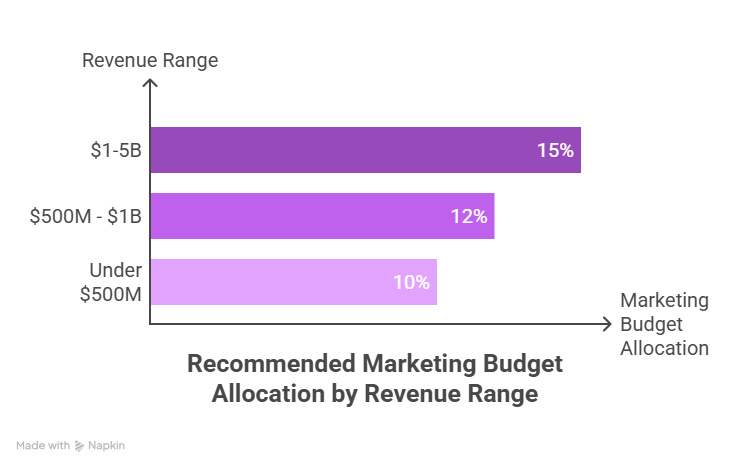
Regardless of the size of your organization or the vertical that you operate in, a common question asked by many CMOs revolves around marketing investment and the optimal level of spending based on the size of the business. There are many variables that can have an impact on your budget, and there’s no right or wrong answer. We can, however, provide some strategic guidance in determining the most effective spend based on your business metrics.
Let’s look at some of internal and external factors that can help define what the “best” marketing budget number may look like for you.
As a Percentage of Revenue, How Much Should We Allocate to Marketing?
One of the simplest, most effective ways to calculate your marketing budget is based on a percentage of your company’s gross annual revenue. Using these general rules of thumb from the Gartner CMO Spend Survey 2025 can help you calculate your company’s ideal marketing budget:

These ranges will allow sufficient support of internal and external activities to help maintain a strong market presence.
However, there are some variables that call for a significant departure from this formula. These include:
Brand Lifecycle: For some marketers, the focus will be more long-term in nature which will equate to objectives revolving around items such as brand equity, purchase intent, and market share. The inverse of this is a short-term strategy, generally centric to sales activity and volume.
Brand builders generally will see a higher percentage as well, as brand centric efforts take a longer duration of sustained investment to be realized. Those embarking in a brand building exercise will generally tend to invest in both brand efforts and performance centric efforts to cover the short-term and long-term needs of the organization.
Those who are centric to performance objectives tend to see a slightly lower percentage.
If you are interested in learning more about short-term vs. long-term strategy, check out our recent blog on the topic.
Product/Service/Market Introductions: If you’re launching a new product or service, or entering a new market, you’ve probably taken the time to assess your budgetary requirements. Additional investment will be required, and these variables will impact the outcome.
Competitive Entrants: A particularly competitive market may force your hand. Market share retention is significantly less costly than market share acquisition so, should you have a competitor pushing or entering your market, it would be a wise decision to rally with them to ensure market equity does not erode.
Digital Advertising: Companies that heavily rely on digital advertising tend to see a higher percentage of marketing budget allocation. This may seem counterintuitive for some, but the relative cost of digital media is much more inline with traditional advertising mediums. That being said, digital advertising does offer lower barriers to entry as minimum investment levels tend to be much lower than traditional forms of advertising.
The real driver behind these higher percentages is the ability to attribute incremental revenue back to the investments, consequently making a business case much easier to articulate across the organization and much easier for an organization to support this approach.
Owned Assets (Web/Ecommerce): Investing in an updated or new web/mobile presence or an ecommerce platform will have significant implications on your budget. The percentage increase will be consistent whether you’re a SMB or an Enterprise business, since the range of the platform requirements will scale with the size and scope of the organization.
B2C marketers will likely require higher budgets than B2B marketers because the consumer expectation variable is moving so quickly to a web/mobile UX perspective that the iteration period is much shorter than their B2B marketing counterparts.
Each individual business will ultimately need to find their own path, but one common theme will apply to everyone– the scale of the marketing budget should be sufficient to accomplish the strategic objectives identified by the organization. More complex and broad priorities will require a more robust budget.
For so many marketers, the budget allocation simply isn’t realistic to accomplish the goals of the organization. Understanding this is vital. Equally as vital is communicating to set proper expectations across the organization as to what the priorities will be and what is realistic to accomplish. If you fail to do this, the optics and human impact will be real as the organization will likely begin to search for someone who will be able to accomplish the mandate.
Need help determining a marketing budget that’s right for your company? Drop us a line.